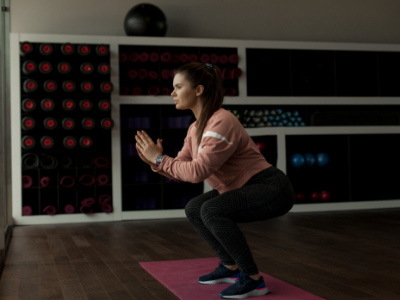Ahhh, cardio… Anyone who knows me knows that it’s definitely not my favorite thing in the world. While I’d often much rather be ripping some heavy weight off the ground with a deadlift or propelling my body through the air with an empowering chin-up, I’ve found ways to make cardio much more exciting than trudging along on the elliptical, especially when the weather makes it challenging to go outside.
Here are some of my absolute favorite indoor conditioning movements. Some can be done at home, others require a gym.
Manual Treadmill Sprints
Intermediate/Advanced
These things are beautifully challenging, and will have you sucking wind harder than just about any other exercise. In fact, I usually have a hard time doing them for much longer than 10–15 seconds if I am really challenging myself!
 Start with the treadmill turned off (hence: manual treadmill sprints), put your hands on the rail in front of you, and start pushing! The harder you push, the faster you go, the more challenging it will be. When you’ve reached your limit, keep holding on to the railing and jump to the sides while the treadmill slows to a stop. Walk around a little bit and try to catch your breath while you rest. You can rest a certain amount of time or rest until you get back to a certain heart rate level.
Start with the treadmill turned off (hence: manual treadmill sprints), put your hands on the rail in front of you, and start pushing! The harder you push, the faster you go, the more challenging it will be. When you’ve reached your limit, keep holding on to the railing and jump to the sides while the treadmill slows to a stop. Walk around a little bit and try to catch your breath while you rest. You can rest a certain amount of time or rest until you get back to a certain heart rate level.
I generally start with 10–15 seconds of work, rest until my heart rate gets back to 120 bpm (around 90–120 seconds), and typically do around six intervals. To progress in this exercise from one week to the next, you can do any of the following:
- Increase your work period.
- Decrease your rest period.
- Increase the number of intervals your perform.
Plate Pushes
High-Level Beginner/Intermediate/Advanced
Plate pushes are a great alternative when you don’t have access to a prowler. Start with at least one 25-pound plate — you can use heavier plates and use multiple ones depending of your strength and conditioning level — and simply push it across the floor (remember, simple doesn’t always mean easy!)
 Keep in mind that depending on the material of your plates and the surface of the floor you may have to place the plates on a towel of some sort. I like to push for 20–30 yards, rest 20–30 seconds, push it back, and then rest 60–90 seconds, performing 4–7 sets total (each set equals to pushing 20–30 yards and back).
Keep in mind that depending on the material of your plates and the surface of the floor you may have to place the plates on a towel of some sort. I like to push for 20–30 yards, rest 20–30 seconds, push it back, and then rest 60–90 seconds, performing 4–7 sets total (each set equals to pushing 20–30 yards and back).
Remember to keep a long, neutral spine and neutral head while pushing.
To progress in this exercise from one week to the next, you can do any of the following:
- Increase the weight of the plate.
- Increase the distance traveled.
- Decrease the rest periods.
- Add more sets.
Farmer’s Walks
Beginner/Intermediate/Advanced
The mechanics of farmer’s walks are fairly simple: you pick up relatively heavy weights, hold them at your sides, and carry them for a certain distance. You can use dumbbells, kettlebells, plates, or farmer’s walk implements (typically handles that allow you to add weight plates). Again, simple doesn’t mean easy, and the key to this exercise is to challenge yourself.
Make sure that you pick up the weights with a neutral spine, and keep a proper alignment as you walk Don’t shrug your shoulders up as you perform the exercise — if you find yourself shrugging, it may be a sign that the weights you use are too light.
 Weights used for this exercise will vary widely among individuals — pick weights that feels challenging and walk until you think you might drop them, stopping and putting down the weights when you feel like your grip will give out (please be mindful of safety here — your own and others’ too). Rest a minute or so, and go again.
Weights used for this exercise will vary widely among individuals — pick weights that feels challenging and walk until you think you might drop them, stopping and putting down the weights when you feel like your grip will give out (please be mindful of safety here — your own and others’ too). Rest a minute or so, and go again.
This is a great way to work on your conditioning and your grip! Remember that you want to base your distance on how much weight you are carrying and vice versa. If you don’t have much space available, pick up something heavier. If you don’t have very heavy tools to carry, plan on walking a longer distance. I like to do 6–8 trips to start out.
To progress in this exercise from one week to the next, you can do any of the following:
- Walk a longer distance.
- Walk more quickly (while keeping control and good alignment).
- Use offset weights (one side is heavier than the other, switch each time).
- Shorten the rest period.
- Increase the number of sets.
Interval Circuits
Beginner/Intermediate/Advanced
Interval Training — that is, timed work intervals followed by timed rest intervals — can be a great option for every ability level, depending on the movements chosen for the circuit. Here are some examples of movement combinations:
Beginner Options
- Wall sits and band pull-aparts
- Bodyweight box squats and walk-outs
Intermediate Options
- Battling rope and modified burpees
- Medicine ball slams and T-plank holds
Advanced Options
- Kettlebell swings and heavy medicine ball slams
- Goblet squats and mountain climbers
As you can see, you can make these circuits significantly harder or easier based on the movements you pick, the weight you use (if any), and the speed at which you perform the exercises.
 After you have chosen 1–4 exercises that fit your ability level, make sure that you have plenty of space and that no one is going to try and “work in” with you during your set. Set a timer (using an interval timer app) for 6–10 rounds of 30 seconds of work followed by 30 seconds of rest.
After you have chosen 1–4 exercises that fit your ability level, make sure that you have plenty of space and that no one is going to try and “work in” with you during your set. Set a timer (using an interval timer app) for 6–10 rounds of 30 seconds of work followed by 30 seconds of rest.
Perform your chosen exercises at a controlled but very quick pace (the quicker you perform them, the harder it will be, so keep that in mind) for the work interval.
Depending on the intensity at which you are working, your “rest” interval may not necessarily give you enough time to rest, but do take a couple of breaths and set up for your next exercise.
At the end of this workout, you should be quite winded and not able to maintain a normal level of conversation for at least a few minutes. Remember that your ability level will dictate how hard you’re able to push, and that you should not sacrifice form but maintain quality movement throughout.
Bodyweight Metabolic Circuit
Beginner/Intermediate/Advanced
Here you choose 4–6 exercises to perform with minimal rest in between. You can choose any set or rep scheme that you’d like. Here are a few of my favorite options:
- Complete 8 reps of an exercise, then move to the next exercise, and so on until you have completed the circuit 3–4 times.
- Use a descending pyramid scheme, doing 6 reps of each exercise, then 5, then 4, then 3, and so on until you are only doing 1 rep of each exercise.
- Use an ascending pyramid scheme, doing 1 rep of each exercise and then 2, and then 3, and so on until you get to 6 or 8 or 10 reps, whatever you prefer.
- Pyramid up and then back down: 1, 2, 3, 4, 5, 5, 4, 3, 2, 1, etc.
- Complete the exercises for a set amount of time (i.e., 15 seconds) instead of a set amount of reps, and each time try to perform more reps.
As you can see, there are many ways to set up your metabolic circuit. You can find your favorite one or switch it up each time. Like I mentioned above, make sure you choose exercises that are appropriate for your ability level and make sure you have mastered the exercise before trying to do it in a fatigued state.
Here are some examples of body weight circuits I might do with each ability level:
Beginner Circuit
8–10 reps of each exercise, rest 15 seconds in between. Complete the circuit 2–3 times.
- Bodyweight box squat
- Walk-out (walk your hands out to push-up position, hold it, walk hands back, stand up, repeat)
- Glute bridge with mini-band around knees
- Bear crawl (20 yards instead of 8 reps)
- Band pull-apart
- Wall sit (20 seconds instead of 8 reps)
 Intermediate Circuit
Intermediate Circuit
Start with 8 reps, work down to 1 rep, no rest between exercises. Rest 30 seconds between circuits.
- Bodyweight squat
- Inverted row
- Split squat
- Modified burpee
- Single-leg glute bridge
- Bear crawl (30 yards every time, instead of descending reps)
Advanced Circuit
Start with 6 reps, work down to 1 rep and back up to 6 reps. Rest 20 seconds between exercises, no extra rest between circuits.
- Jump squat
- Chin-up
- Walking lunge
- Push-up
- Mountain climber (20 each side, instead of changing reps)
- Plate push (30 yards, instead of changing reps)
As you can see, you can increase the intensity and difficulty of the exercise by changing the exercise, increasing the speed at which you do the exercise, increasing the reps, decreasing the rest, doing more total circuits… the list goes on and on.
Hopefully you have gotten some great ideas to shake things up a bit for your indoor conditioning sessions so you don’t dread them but see them as a great opportunity to have fun while breaking a sweat!
FREE course – 5 SECRETS TO GET MORE RESULTS IN LESS TIME
Learn the most effective strategies for getting the exact results you want — without spending your life in the gym.
Our Girls Gone Strong Formula has helped thousands of women all over the globe get the results they’re looking for.
Now we’re sharing our secrets with you. Click the button below to get your first free lesson
stand the Blueprint and be willing to trust the process.

